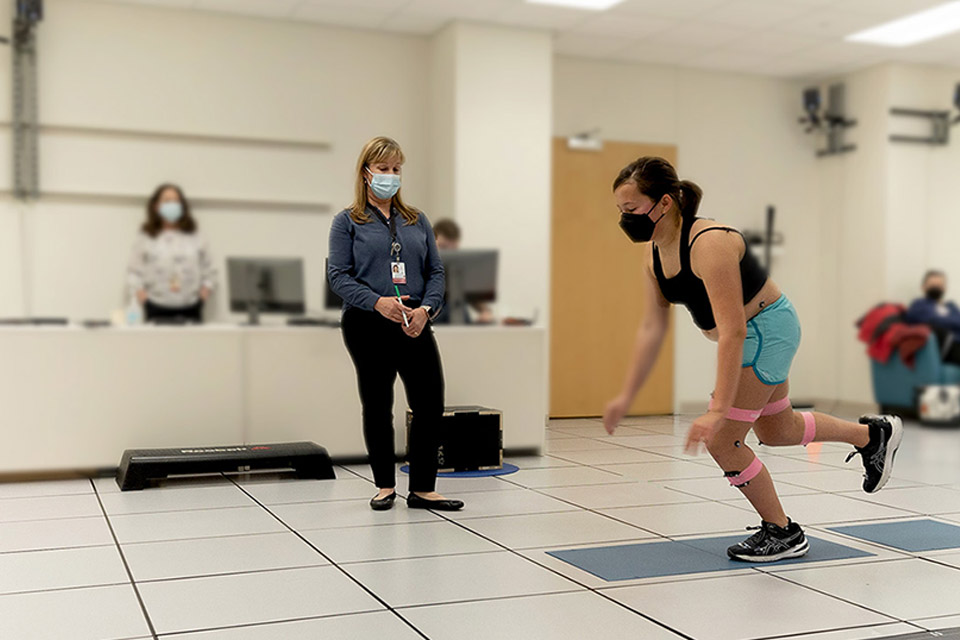Legg-Calvé-Perthes Care
Legg-Calvé-Perthes disease, or Perthes disease, is a childhood bone disorder that typically only affects one hip, although roughly 10% of children experience it in both hips.
Symptoms tend to appear between the ages of 4 and 8, and boys are four times more likely to get Perthes disease.
Legg-Calvé-Perthes disease is caused by disrupted blood flow to the femoral head of the thigh bone. This may result in necrosis and collapse of the bone in the femoral head. New bone eventually replaces the old, but the previous rounded shape of the bone may now be abnormal.
When blood stops flowing to the femoral head, it begins breaking down and losing its round shape, making it difficult to fit and move in the hip socket as it should. This impacts mobility, causes pain, and can lead to early-onset osteoarthritis.
Specific treatments and services may vary by location. Please contact a specific location for more information.
I was diagnosed in 2009. It started in my left hip, and then it moved to my right. Shriners Children's is so loving and caring – they really care about you.
Treatment options for Legg-Calvé-Perthes
Treatment options vary, and your child will receive a personalized treatment plan that incorporates the most advanced and innovative techniques. Our focus is early detection and a customized treatment plan that is as noninvasive as possible.
Non-surgical
Children under 6 years old tend to respond best to non-surgical interventions, which may include anti-inflammatory medications, activity restrictions (crutches or a wheelchair to reduce weight bearing), bracing or casting, and physical therapy to maintain motion.
Surgical
Surgery of the femur or the socket may be necessary to improve the shape of the joint so that the femoral head remains covered by the socket, and to prevent future arthritis.
Locations for Legg-Calvé-Perthes Care
View All Related Locations
{"items":[{"title":"Shriners Children's Tri-Cities Clinic","image":"https://www.shrinerschildrens.org/-/media/images/shc/location-entities/spokane/kadlec_clinic_961x640_85786.ashx?sc_lang=en","imageAlt":null,"text":"The Shriners Children's Tri-Cities Clinic is convenient for those who live in central Washington.","ctaItem":{"ctaLinkIcon":"https://www.shrinerschildrens.org/-/media/icons/si-nonhero-icons-_-24x24px/solid-white-_-24x24px/mappin_24x24_whitesolid.ashx","ctaLinkText":"More About This Location","ctaLink":"/en/Locations/Spokane/Clinics/Tri-Cities-Clinic"},"itemId":"051085b9-83a2-40c1-a414-20b7df5315b4"},{"title":"Shriners Children's Boys Town Clinic","image":"https://www.shrinerschildrens.org/-/media/images/shc/location-entities/twin-cities/male_clinic_patient_with_orthotic_devices_961x640_121350.ashx","imageAlt":null,"text":"The Shriners Children's Boys Town Clinic is an extension of Shriners Children's Twin Cities, convenient for families in the Omaha area.","ctaItem":{"ctaLinkIcon":"https://www.shrinerschildrens.org/-/media/icons/si-nonhero-icons-_-24x24px/solid-white-_-24x24px/mappin_24x24_whitesolid.ashx","ctaLinkText":"More About This Location","ctaLink":"/en/Locations/Twin-Cities/Clinics/Boys-Town-Clinic"},"itemId":"128bf0b4-6079-4481-b3a7-7f0c8f7442be"},{"title":"Shriners Children's Spokane","image":"https://www.shrinerschildrens.org/-/media/images/shc/location-entities/spokane/spokane_building_exterior_961x640_2011.ashx","imageAlt":null,"text":"Pediatric specialty care for children throughout Washington and beyond","ctaItem":{"ctaLinkIcon":"https://www.shrinerschildrens.org/-/media/icons/si-nonhero-icons-_-24x24px/solid-white-_-24x24px/mappin_24x24_whitesolid.ashx","ctaLinkText":"More About This Location","ctaLink":"/en/Locations/Spokane"},"itemId":"dcde3508-5aaa-4593-b2cc-9deb7b6e90e9"},{"title":"Shriners Children's Florida Extended Care","image":"https://www.shrinerschildrens.org/-/media/images/shc/location-entities/florida/florida_illustration_960x640_326058205.ashx","imageAlt":null,"text":"Pediatric specialty care for children throughout Florida.","ctaItem":{"ctaLinkIcon":"https://www.shrinerschildrens.org/-/media/icons/si-nonhero-icons-_-24x24px/solid-white-_-24x24px/mappin_24x24_whitesolid.ashx","ctaLinkText":"More About This Location","ctaLink":"/en/Locations/Florida"},"itemId":"a676f904-d419-4299-a0ba-73866cbc6eba"},{"title":"Shriners Children's Erie","image":"https://www.shrinerschildrens.org/-/media/images/shc/location-entities/erie/erie_building_exterior_961x640_63710.ashx","imageAlt":null,"text":"Pediatric specialty care for children throughout Pennsylvania and beyond","ctaItem":{"ctaLinkIcon":"https://www.shrinerschildrens.org/-/media/icons/si-nonhero-icons-_-24x24px/solid-white-_-24x24px/mappin_24x24_whitesolid.ashx","ctaLinkText":"More About This Location","ctaLink":"/en/Locations/Erie"},"itemId":"621762eb-f29e-42c1-b6d5-759ea1575336"},{"title":"Shriners Children's Twin Cities","image":"https://www.shrinerschildrens.org/-/media/images/shc/location-entities/twin-cities/twin_cities_building_exterior_961x640_65422.ashx","imageAlt":null,"text":"Pediatric specialty care for children throughout Minnesota and beyond","ctaItem":{"ctaLinkIcon":"https://www.shrinerschildrens.org/-/media/icons/si-nonhero-icons-_-24x24px/solid-white-_-24x24px/mappin_24x24_whitesolid.ashx","ctaLinkText":"More About This Location","ctaLink":"/en/Locations/Twin-Cities"},"itemId":"058ff587-891a-4c75-8853-9a15542fd911"},{"title":"Shriners Children's Salt Lake City","image":"https://www.shrinerschildrens.org/-/media/images/shc/location-entities/salt-lake-city/salt_lake_city_hospital_exterior_961x640_37973.ashx","imageAlt":null,"text":"Pediatric specialty care for children throughout Utah and beyond","ctaItem":{"ctaLinkIcon":"https://www.shrinerschildrens.org/-/media/icons/si-nonhero-icons-_-24x24px/solid-white-_-24x24px/mappin_24x24_whitesolid.ashx","ctaLinkText":"More About This Location","ctaLink":"/en/Locations/Salt-Lake-City"},"itemId":"e95b0b3a-8781-4297-b048-046b1abd59e0"},{"title":"Shriners Children's Guadalajara Clinic","image":"https://www.shrinerschildrens.org/-/media/images/shc/location-entities/mexico/male_patient_on_crutches_960x640_255258.ashx","imageAlt":null,"text":"The Shriners Children's Guadalajara Orthopedic Clinic provides care at no cost to children ages 0 to 18.","ctaItem":{"ctaLinkIcon":"https://www.shrinerschildrens.org/-/media/icons/si-nonhero-icons-_-24x24px/solid-white-_-24x24px/mappin_24x24_whitesolid.ashx","ctaLinkText":"More About This Location","ctaLink":"/en/Locations/Mexico/Clinics/Guadalajara-clinic"},"itemId":"53371fe7-375f-4dde-bc47-9c5fac519896"},{"title":"Shriners Children's Yakima Clinic","image":"https://www.shrinerschildrens.org/-/media/images/shc/location-entities/spokane/new_life_clinic_961x640_190400.ashx?sc_lang=en","imageAlt":null,"text":"The Shriners Children's Yakima Clinic is convenient for those who live in central Washington.","ctaItem":{"ctaLinkIcon":"https://www.shrinerschildrens.org/-/media/icons/si-nonhero-icons-_-24x24px/solid-white-_-24x24px/mappin_24x24_whitesolid.ashx","ctaLinkText":"More About This Location","ctaLink":"/en/Locations/Spokane/Clinics/Yakima-Clinic"},"itemId":"4aaf4dd3-ed11-496a-8545-7120db30ebbb"},{"title":"Shriners Children's Culiacan Clinic","image":"https://www.shrinerschildrens.org/-/media/images/shc/location-entities/mexico/two_male_patients_960x640_230285.ashx","imageAlt":null,"text":"The Shriners Children's Culiacán clinic provides specialized orthopedic pediatric care for patients in the northwest of Mexico.","ctaItem":{"ctaLinkIcon":"https://www.shrinerschildrens.org/-/media/icons/si-nonhero-icons-_-24x24px/solid-white-_-24x24px/mappin_24x24_whitesolid.ashx","ctaLinkText":"More About This Location","ctaLink":"/en/Locations/Mexico/Clinics/Culiacan"},"itemId":"92b26202-8210-414c-a9ee-8bfdad34749d"},{"title":"Shriners Children's Kalispell Clinic","image":"https://www.shrinerschildrens.org/-/media/images/shc/location-entities/spokane/patient_mother_961x640_65796.ashx","imageAlt":null,"text":"The Shriners Children's Kalispell Clinic is convenient for those who live in Montana.","ctaItem":{"ctaLinkIcon":"https://www.shrinerschildrens.org/-/media/icons/si-nonhero-icons-_-24x24px/solid-white-_-24x24px/mappin_24x24_whitesolid.ashx","ctaLinkText":"More About This Location","ctaLink":"/en/Locations/Spokane/Clinics/Kalispell-Clinic"},"itemId":"7f67549e-60df-47ae-84cb-f6bd879e62ca"},{"title":"Shriners Children's Redmond Clinic","image":"https://www.shrinerschildrens.org/-/media/images/shc/location-entities/portland/four_staff_members_960x640_261439.ashx","imageAlt":null,"text":"The Shriners Children's Redmond clinic serves families in Central Oregon.","ctaItem":{"ctaLinkIcon":"https://www.shrinerschildrens.org/-/media/icons/si-nonhero-icons-_-24x24px/solid-white-_-24x24px/mappin_24x24_whitesolid.ashx","ctaLinkText":"More About This Location","ctaLink":"/en/Locations/Portland/Clinics/Redmond-Clinic"},"itemId":"bc64b82e-85cd-45e2-bd80-e3307fdf9845"},{"title":"Shriners Children's Doylestown Clinic","image":"https://www.shrinerschildrens.org/-/media/images/shc/location-entities/philadelphia/doylestown_clinic_teaser_960x640_s9tdpisgrl6hp5olrejhskua65.ashx","imageAlt":null,"text":"Shriners Children's Philadelphia has a clinic in Doylestown, Pennsylvania, where patients can be seen for new patient appointments, follow-up appointments and fractures.","ctaItem":{"ctaLinkIcon":"https://www.shrinerschildrens.org/-/media/icons/si-nonhero-icons-_-24x24px/solid-white-_-24x24px/mappin_24x24_whitesolid.ashx","ctaLinkText":"More About This Location","ctaLink":"/en/Locations/Philadelphia/Clinics/Doylestown-Clinic"},"itemId":"00632836-8944-42d7-b7c7-0b61233e0ec2"},{"title":"Shriners Children's Chicago","image":"https://www.shrinerschildrens.org/-/media/images/shc/location-entities/chicago/chicago_hospital_exterior_961x640_65608.ashx","imageAlt":null,"text":"Pediatric specialty care for children throughout Illinois and beyond","ctaItem":{"ctaLinkIcon":"https://www.shrinerschildrens.org/-/media/icons/si-nonhero-icons-_-24x24px/solid-white-_-24x24px/mappin_24x24_whitesolid.ashx","ctaLinkText":"More About This Location","ctaLink":"/en/Locations/Chicago"},"itemId":"be4595bd-0b81-4f87-9e04-1a2141481d8a"},{"title":"Shriners Children's Greenville","image":"https://www.shrinerschildrens.org/-/media/images/shc/location-entities/greenville/greenville_hospital_exterior_961x640_318.ashx","imageAlt":null,"text":"Pediatric specialty care for children throughout South Carolina and beyond","ctaItem":{"ctaLinkIcon":"https://www.shrinerschildrens.org/-/media/icons/si-nonhero-icons-_-24x24px/solid-white-_-24x24px/mappin_24x24_whitesolid.ashx","ctaLinkText":"More About This Location","ctaLink":"/en/Locations/Greenville"},"itemId":"ab596397-ce95-4df0-b34d-a8f5b40257a3"},{"title":"Shriners Hospitals for Children Canada","image":"https://www.shrinerschildrens.org/-/media/images/shc/location-entities/canada/canada_hospital_exterior_961x640_65566.ashx","imageAlt":null,"text":"Pediatric specialty care for children throughout Montreal and beyond","ctaItem":{"ctaLinkIcon":"https://www.shrinerschildrens.org/-/media/icons/si-nonhero-icons-_-24x24px/solid-white-_-24x24px/mappin_24x24_whitesolid.ashx","ctaLinkText":"More About This Location","ctaLink":"/en/Locations/Canada"},"itemId":"e304f501-802a-473c-854b-e1e7274922bb"},{"title":"Shriners Children's Lexington","image":"https://www.shrinerschildrens.org/-/media/images/shc/location-entities/lexington/lexington_building_exterior_961x640_16062.ashx","imageAlt":null,"text":"Pediatric specialty care for children throughout Kentucky and beyond","ctaItem":{"ctaLinkIcon":"https://www.shrinerschildrens.org/-/media/icons/si-nonhero-icons-_-24x24px/solid-white-_-24x24px/mappin_24x24_whitesolid.ashx","ctaLinkText":"More About This Location","ctaLink":"/en/Locations/Lexington"},"itemId":"56377c4e-fade-41e8-a056-d3b0a5beee62"},{"title":"Shriners Children's Chihuahua Clinic","image":"https://www.shrinerschildrens.org/-/media/images/shc/location-entities/mexico/shriners_childrens_chihuahua_exterior_960x640_17jlfn0gh11i33llj8j0fgve4r.ashx","imageAlt":null,"text":"The Shriners Children's Chihuahua Orthopedic Clinic provides care to children ages 0 to 18 at no cost.","ctaItem":{"ctaLinkIcon":"https://www.shrinerschildrens.org/-/media/icons/si-nonhero-icons-_-24x24px/solid-white-_-24x24px/mappin_24x24_whitesolid.ashx","ctaLinkText":"More About This Location","ctaLink":"/en/Locations/Mexico/Clinics/Chihuahua-Clinic"},"itemId":"8c80e1f0-7a25-4087-88e7-51a521eee3df"},{"title":"Shriners Children's Shreveport","image":"https://www.shrinerschildrens.org/-/media/images/shc/location-entities/shreveport/shreveport_building_exterior_961x640_69307.ashx","imageAlt":null,"text":"Pediatric specialty care for children throughout Louisiana and beyond","ctaItem":{"ctaLinkIcon":"https://www.shrinerschildrens.org/-/media/icons/si-nonhero-icons-_-24x24px/solid-white-_-24x24px/mappin_24x24_whitesolid.ashx","ctaLinkText":"More About This Location","ctaLink":"/en/Locations/Shreveport"},"itemId":"e6b240cf-ad3e-4c40-84f9-8ea1b2bd7dc6"},{"title":"Shriners Children's Philadelphia","image":"https://www.shrinerschildrens.org/-/media/images/shc/location-entities/philadelphia/philadelphia_hospital_exterior_961x640_65326.ashx","imageAlt":null,"text":"Pediatric specialty care for children throughout Pennsylvania and beyond","ctaItem":{"ctaLinkIcon":"https://www.shrinerschildrens.org/-/media/icons/si-nonhero-icons-_-24x24px/solid-white-_-24x24px/mappin_24x24_whitesolid.ashx","ctaLinkText":"More About This Location","ctaLink":"/en/Locations/Philadelphia"},"itemId":"4ba856fc-9284-4234-b570-0006dc4d792a"},{"title":"Shriners Children's Southern California","image":"https://www.shrinerschildrens.org/-/media/images/shc/location-entities/southern-california/front_of_building_961x640_60428.ashx","imageAlt":null,"text":"Pediatric specialty care for children throughout California and beyond","ctaItem":{"ctaLinkIcon":"https://www.shrinerschildrens.org/-/media/icons/si-nonhero-icons-_-24x24px/solid-white-_-24x24px/mappin_24x24_whitesolid.ashx","ctaLinkText":"More About This Location","ctaLink":"/en/Locations/Southern-California"},"itemId":"ffc85f4f-14e6-480d-80b2-456c9db492e9"},{"title":"Shriners Children's Rapid City Clinic","image":"https://www.shrinerschildrens.org/-/media/images/shc/location-entities/twin-cities/female_patient_961x640_65382.ashx","imageAlt":null,"text":"The Rapid City Clinic of Shriners Children's Twin Cities is convenient for those who live in the Rapid City, South Dakota area.","ctaItem":{"ctaLinkIcon":"https://www.shrinerschildrens.org/-/media/icons/si-nonhero-icons-_-24x24px/solid-white-_-24x24px/mappin_24x24_whitesolid.ashx","ctaLinkText":"More About This Location","ctaLink":"/en/Locations/Twin-Cities/Clinics/Rapid-City-Clinic"},"itemId":"99fee9b6-7dc6-44a4-b820-c276064ddbe4"},{"title":"Shriners Children's Monterrey Clinic","image":"https://www.shrinerschildrens.org/-/media/images/shc/location-entities/mexico/female_patient_female_provider_960x640_247158.ashx","imageAlt":null,"text":"Shriners Children's Mexico expands its frontiers of specialty medical care and opens its doors in the city of Monterrey.","ctaItem":{"ctaLinkIcon":"https://www.shrinerschildrens.org/-/media/icons/si-nonhero-icons-_-24x24px/solid-white-_-24x24px/mappin_24x24_whitesolid.ashx","ctaLinkText":"More About This Location","ctaLink":"/en/Locations/Mexico/Clinics/Monterrey"},"itemId":"59b1e5f4-5b39-415a-a77f-e130b94a065a"},{"title":"Shriners Children's Medford Clinic","image":"https://www.shrinerschildrens.org/-/media/images/shc/location-entities/portland/eight_shriners_medford_clinic_960x640_275393.ashx","imageAlt":null,"text":"Shriners Children's Medford Clinic is an extension of Shriners Children's Portland, conveniently located for families in southern Oregon.","ctaItem":{"ctaLinkIcon":"https://www.shrinerschildrens.org/-/media/icons/si-nonhero-icons-_-24x24px/solid-white-_-24x24px/mappin_24x24_whitesolid.ashx","ctaLinkText":"More About This Location","ctaLink":"/en/Locations/Portland/Clinics/Medford-Clinic"},"itemId":"2676282c-b73c-41d3-af10-cd3a293e5598"},{"title":"Shriners Children's Fairbanks Clinic","image":"https://www.shrinerschildrens.org/-/media/images/shc/pediatric-care/patient_clinic_cast_961x640_66194.ashx","imageAlt":null,"text":"The Shriners Children's Fairbanks Clinic is convenient for those who live in Alaska.","ctaItem":{"ctaLinkIcon":"https://www.shrinerschildrens.org/-/media/icons/si-nonhero-icons-_-24x24px/solid-white-_-24x24px/mappin_24x24_whitesolid.ashx","ctaLinkText":"More About This Location","ctaLink":"/en/Locations/Spokane/Clinics/Fairbanks-Clinic"},"itemId":"a368a0a8-894a-4052-a512-84204be77def"},{"title":"Shriners Children's Hawai`i","image":"https://www.shrinerschildrens.org/-/media/images/shc/location-entities/hawaii/honolulu_hospital_exterior_961x640_284.ashx","imageAlt":null,"text":"Pediatric specialty care for children throughout Hawai`i and beyond","ctaItem":{"ctaLinkIcon":"https://www.shrinerschildrens.org/-/media/icons/si-nonhero-icons-_-24x24px/solid-white-_-24x24px/mappin_24x24_whitesolid.ashx","ctaLinkText":"More About This Location","ctaLink":"/en/Locations/Hawaii"},"itemId":"d06e3dc7-5685-4839-a75c-c8a154c874d2"},{"title":"Shriners Children's New England","image":"https://www.shrinerschildrens.org/-/media/images/shc/location-entities/new-england/springfield_building_exterior_961x640_63900.ashx","imageAlt":null,"text":"Pediatric specialty care for children throughout Massachusetts and beyond","ctaItem":{"ctaLinkIcon":"https://www.shrinerschildrens.org/-/media/icons/si-nonhero-icons-_-24x24px/solid-white-_-24x24px/mappin_24x24_whitesolid.ashx","ctaLinkText":"More About This Location","ctaLink":"/en/Locations/New-England"},"itemId":"0378db05-94c6-49b9-ba00-72d4317b4d4a"},{"title":"Shriners Children's St. Louis","image":"https://www.shrinerschildrens.org/-/media/images/shc/location-entities/st-louis/st_louis_hospital_exterior_961x640_298.ashx","imageAlt":null,"text":"Pediatric specialty care for children throughout Missouri and beyond","ctaItem":{"ctaLinkIcon":"https://www.shrinerschildrens.org/-/media/icons/si-nonhero-icons-_-24x24px/solid-white-_-24x24px/mappin_24x24_whitesolid.ashx","ctaLinkText":"More About This Location","ctaLink":"/en/Locations/St-Louis"},"itemId":"5603c75f-6a8f-41e8-8d1a-a1b5e82b8940"},{"title":"Shriners Children's Northern California","image":"https://www.shrinerschildrens.org/-/media/images/shc/location-entities/ncal/sacramento_building_exterior_961x640_294.ashx","imageAlt":null,"text":"Pediatric specialty care for children throughout Northern California, Western U.S., Northwestern Mexico and Canada","ctaItem":{"ctaLinkIcon":"https://www.shrinerschildrens.org/-/media/icons/si-nonhero-icons-_-24x24px/solid-white-_-24x24px/mappin_24x24_whitesolid.ashx","ctaLinkText":"More About This Location","ctaLink":"/en/Locations/Northern-California"},"itemId":"6912ff77-30d5-4c8a-bf67-783c912358d0"},{"title":"Shriners Children's Texas","image":"https://www.shrinerschildrens.org/-/media/images/shc/location-entities/texas/texas_building_exterior_961x640_63296.ashx","imageAlt":null,"text":"Pediatric specialty care for children throughout Texas and beyond","ctaItem":{"ctaLinkIcon":"https://www.shrinerschildrens.org/-/media/icons/si-nonhero-icons-_-24x24px/solid-white-_-24x24px/mappin_24x24_whitesolid.ashx","ctaLinkText":"More About This Location","ctaLink":"/en/Locations/Texas"},"itemId":"a32d4e02-f720-4176-b90b-80f85649936c"},{"title":"Shriners Children's Mexico","image":"https://www.shrinerschildrens.org/-/media/images/shc/location-entities/mexico/mexico_hospital_exterior_961x640_62500.ashx","imageAlt":null,"text":"Pediatric Specialty Care for children throughout Northern California, Western US, Mexico and Canada","ctaItem":{"ctaLinkIcon":"https://www.shrinerschildrens.org/-/media/icons/si-nonhero-icons-_-24x24px/solid-white-_-24x24px/mappin_24x24_whitesolid.ashx","ctaLinkText":"More About This Location","ctaLink":"/en/Locations/Mexico"},"itemId":"038454f1-2cf5-4df9-9b3a-157f4d7e8a2f"},{"title":"Shriners Children's Portland","image":"https://www.shrinerschildrens.org/-/media/images/shc/location-entities/portland/portland_building_exterior_961x640_63358.ashx","imageAlt":null,"text":"Pediatric specialty care for children throughout Oregon and beyond","ctaItem":{"ctaLinkIcon":"https://www.shrinerschildrens.org/-/media/icons/si-nonhero-icons-_-24x24px/solid-white-_-24x24px/mappin_24x24_whitesolid.ashx","ctaLinkText":"More About This Location","ctaLink":"/en/Locations/Portland"},"itemId":"8379ad6f-7220-497f-91f2-e0f8d341283a"}]}

Physical Therapy
Innovative Treatments
View All Related Treatments
Pediatric Orthotic and Prosthetic Services (POPS)

Physical Therapy

Motion Analysis

Sports Injury Surgery

Pediatric Orthotic and Prosthetic Services (POPS)

Physical Therapy

Motion Analysis

Sports Injury Surgery

